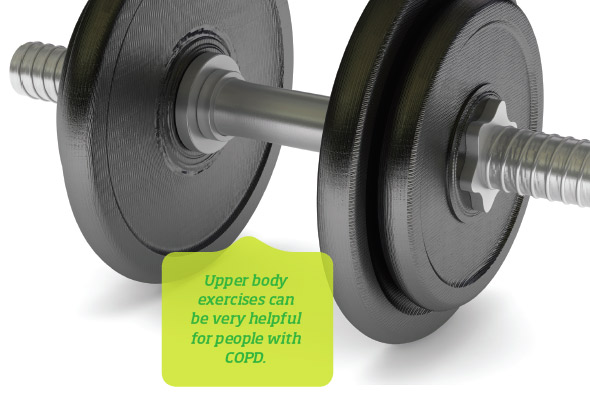
Lung Health and Exercise

According to the American Lung Association, the average adult takes 15 to 20 breaths a minute or in a given day over 20,000 breaths. The important respiratory system is made up of our nose, throat, trachea and lungs.
We may take our lungs for granted until we have an acute episode like a cold or allergy that impairs our ability to breathe and perform routine day to day activities. The respiratory system can also be compromised due to chronic conditions such as Chronic Obstructive Pulmonary Disease (COPD) or acute, severe conditions like pneumonia.
With COPD, one of the common symptoms is shortness of breath during activities due to the restriction of air flow during inhaling or exhaling. Therefore, many individuals with COPD have what can appear to be an intolerance to exercise.
There are many reasons for an individual with COPD to engage in exercise and activities that are physically challenging. Exercise or physical activities help improve the efficiency of oxygen use and overall endurance. Exercise can also enhance muscle strength, balance and overall flexibility. As exercise improves the ability to perform activities, the symptom of shortness of breath lessens.
Always consult your health care professional before engaging in new exercises or starting an exercise program in general. Anyone with lung disease needs to consider the type, amount, and frequency of exercise. Additionally, stretching, cardiovascular and strengthening exercises should be incorporated into the regime. Lastly, make sure the activities you chose are interesting, pleasurable and provide personal gratification.
A warm-up type of exercise is important to prepare the heart and lungs for the conditioning phase of exercise. Warm
up exercises can include stretching, range of motion exercises and low intensity exercises. This portion of an exercise routine slowly increases the breathing demands and circulation levels (heart rate).
The aerobic conditioning (or cardiovascular) portion of an exercise program can include riding a recumbent or upright stationary bicycle and using a treadmill or walking on a level. During this phase of the exercise, it is important to measure your intensity of activity through measuring heart rate or exertion levels using the Rate of Perceived Exertion Scale (RPE). The RPE Scale is an easy to use tool for personal use to “assess” the intensity of your workout or any activity. It is a 0 to 10 scale with 0 being (Nothing at all) to 10 being (very, very heavy work). For people with lung conditions, exercising at this phase at a 3 to 4 level is often determined safe and effective.

Strengthening exercises especially upper body exercises can be very helpful for people with COPD. A good measure of strength and endurance of the upper and lower body can be accomplished by performing a 30 second arm curl test and a 30 second chair stand test. These tests can be performed by an exercise professional or rehabilitation professional. Each test provides a baseline for strength and endurance and provides normative data for ages 60 to 94 (male and female). Strengthening exercise equipment can be accessed at a local fitness center or can be acquired at a sporting goods store (hand weights, cuff/ankle weights or exercise bands).
Cooling down after exercise is just as important as warming up prior to conditioning or strengthening. Slowly decreasing the intensity of the exercises and engaging in range of motion or stretching exercises will allow your heart rate, respiration rate and blood pressure to return to resting (pre-exercise) levels.
A few additional considerations for exercising for greater lung health include the frequency and duration of exercise. An initial exercise program can be started every other day and the exercise session should last for at least 20 to 30 minutes. The activity level can then gradually increase. One other important factor is to find an exercise activity that is pleasurable. Consider your personal characteristics: Is socialization important? Do you enjoy structure or self-led activities? Do you like sports or physically demanding leisure activities?
Your pattern of breathing is also important to consider during exercise. Pursed –lip breathing techniques can be used during exercise and other activities of daily living and mobility activities. Pursed-lip breathing technique is when one breathes through the nose with mouth closed then slowly breathes out through pursed partially opened lips. The inhalation phase takes approximately
2 seconds and the exhalation phase is a bit longer about 4 seconds. Exercising while using the pursed-lip breathing technique helps to reduce symptoms of shortness of breath.
Exercise to maintain and improve lung health can help an individual with COPD or other lung conditions live a productive and active life. As with any exercise program, consult your physician for guidance on the type and amount of exercise. You can request that your physician refer you to an exercise or rehabilitation professional familiar with pulmonary conditions. Pulmonary rehabilitation programs may be available at your local hospital.
References:
http://www.lung.org/lung-disease/copd/
http://www.cdc.gov/copd/index.html


